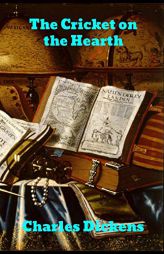
Details
Rent The Cricket on the Hearth: A Fairy Tale of Home
Author:
Format:
Publisher: Brian Westland
Published: Dec 1969
Genre: Fiction - Holidays
Pages: 110
Synopsis
The Cricket on the Hearth: A Fairy Tale of Home is a novella by Charles Dickens, published by Bradbury and Evans, and released 20 December 1845 with illustrations by Daniel Maclise, John Leech, Richard Doyle, Clarkson Stanfield and Edwin Henry Landseer. Dickens began writing the book around 17 October 1845 and finished it by 1 December. Like all of Dickens's Christmas books, it was published in book form, not as a serial.
Dickens described the novel as "quiet and domestic [...] innocent and pretty. It is subdivided into chapters called "Chirps", similar to the "Quarters" of The Chimes or the "Staves" of A Christmas Carol. It is the third of Dickens's five Christmas books, preceded by A Christmas Carol (1843) and The Chimes (1844), and followed by The Battle of Life (1846) and The Haunted Man and the Ghost's Bargain (1848).
The book was a huge commercial success, quickly going through two editions.[2] Reviews were favourable, but not all so. In an unsigned piece in The Times the reviewer opined, "We owe it to literature to protest against this last production of Mr. Dickens [...] Shades of Fielding and Scott! Is it for such jargon as this that we have given your throne to one who cannot estimate his eminence?"[4] However, William Makepeace Thackeray enjoyed the book immensely: "To us, it appears it is a good Christmas book, illuminated with extra gas, crammed with extra bonbons, French plums and sweetness [...] This story is no more a real story than Peerybingle is a real name.
Dickens's portrayal of the blind girl Bertha is significant. Victorians believed disabilities were inherited, and thus it was not socially acceptable for the blind to marry (although they often did in reality).[6] In fictional courtship plots, the blind were often used to build tension since it was assumed they must be kept from marrying.[6] The fictional portrayal of Bertha is similar to Dickens's description in American Notes (1842) of the deaf and blind girl Laura Bridgman, whom he saw on a visit to the Perkins Institution for the Blind in Boston, Massachusetts.
Modern scholars have given the story little attention, but Andrew Sangers has argued it contains similarities to Shakespeare's comedies and should be seen "both as a significant indication of the tastes of the 1840s and of Dickens himself.
